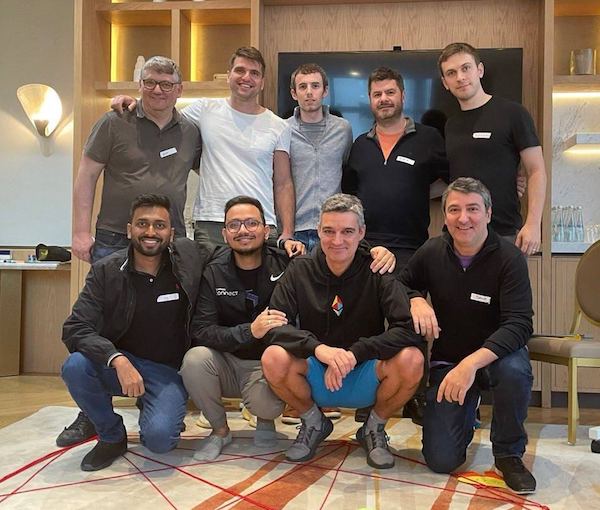ZK-rollups are the hottest thing in Ethereum right now, having seemingly appeared out of nowhere in late 2018 to fundamentally reshape t
ZK-rollups are the hottest thing in Ethereum right now, having seemingly appeared out of nowhere in late 2018 to fundamentally reshape the “Eth2” plan to scale via sharding alone.
Zero-knowledge, or validity proof rollups, essentially perform the computations for many thousands of transactions away from Ethereum and then write a tiny cryptographic proof back to the blockchain that verifies those transactions were performed correctly. It’s much faster and cheaper than using the base layer and has the potential for virtually unlimited scaling.
To an outsider, it looked like the technology went from 0 to 100 in a couple of years, but from the perspective of Polygon Miden founder Bobbin Threadbare, it doesn’t seem fast enough.
“Your internal perception is that it’s moving slowly,” he says. “People say, ‘We’re going to be doing this in a year,’ and it takes longer because people overestimate [how quickly it can be done].”
“But if you take a step back out of your own bubble, I do think that the tech is moving at an amazing pace. A lot of the things we’re doing now did not exist 10 years ago — or even maybe like eight years ago — they were just theoretical concepts.”
“So, it’s not often that you see that something goes from pure theory — that is probably not practical or ‘maybe we can do it in the long term future’ — to ‘OK, we’re doing it now, and there are now billions of dollars riding on it.’”
Polygon Miden at StarkWare Sessions
Magazine catches up with Threadbare at the StarkWare Sessions in Israel. Since Polygon Miden is a competing ZK-rollup solution to StarkWare’s tech, this is a little like interviewing the CEO of Pepsi at a Coca-Cola convention. But it turns out zero-knowledge proofs are not as cutthroat as sodas.
“On the technical side, there is a lot of collaboration,” Threadbare explains. “If you follow Twitter, you may get an impression that people are at each other’s throats all the time, but you know, it’s Twitter more than anything.”
He points out that all of the projects are building open-source technology (or plan to make it open-source). “We’re not building like Web2 walled gardens here,” he says, adding that various projects “don’t necessarily perceive other rollups as their technical competitors; we learn from each other more.”

Polygon is the 8th-most valuable project
Polygon’s MATIC became the eighth-most valuable cryptocurrency in the world thanks to its current Ethereum scaling solution, but Polygon’s founders knew ZK-rollups could potentially render the network obsolete and spent some of their massive war chest on a ZK tech acquisition and hiring spree.
The Polygon team’s approach is essentially to throw a lot of stuff at the wall and see what sticks. Their zkEVM project has just launched on mainnet in beta, and it enables any Ethereum Virtual Machine-compatible project to scale on its new network.
Other ZK flavors at Polygon include Zero (recursive scaling), Hermez 2.0 (an EVM-compatible solution focused on decentralization and a proof-of-efficiency consensus) and Nightfall (Optimistic Rollups meet zero-knowledge cryptography).
Threadbare, who was working for Facebook at the time, was headhunted to develop his open-source ZK technology into Miden.
“This strategy made sense to me; the space is very early,” he says. “I mean, in all honesty, they didn’t even require that I use STARKs, or SNARKs, or anything.” STARKs (zero-knowledge Scalable Transparent Argument of Knowledge) and SNARKs (Succinct Non-Interactive Argument of Knowledge) are the two different types of ZK proof systems.
“They were very open to whatever technology because nobody had the answer. Hopefully, now we have more of an answer than we did like a year or two years ago.”
What is Polygon Miden?
Polygon Miden is essentially the Polygon version of StarkNet. It enables a bunch of transactions to be processed off the main blockchain, and then “validity proof” demonstrating the transactions are computed correctly, to be written back as a single transaction on Ethereum.
STARKs have some advantages over SNARKs in that less trust is required for the setup, and they’ll be resistant to quantum computer attacks. However, STARKs have much, much larger validity proof sizes, which is more expensive to write back to Ethereum.
In another similarity to StarkNet, which uses the Cairo programming language and virtual machine instead of Solidity and EVM, Miden uses its own virtual machine. For both projects, this is a gamble, as it makes it more difficult for Ethereum projects to port over to the rollup. On the other hand, it means Polygon Miden can scale faster and further by enabling it to escape Ethereum’s constraints.
“Within Polygon, we do think about…
cointelegraph.com
